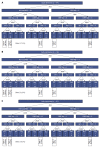Longitudinal molecular characterization of endoscopic specimens from colorectal lesions
- PMID: 27239120
- PMCID: PMC4873886
- DOI: 10.3748/wjg.v22.i20.4936
Longitudinal molecular characterization of endoscopic specimens from colorectal lesions
Abstract
Aim: To compare molecular profiles of proximal colon, distal colon and rectum in large adenomas, early and late carcinomas. To assess feasibility of testing directed at molecular markers from this study in routine clinical practice.
Methods: A prospective 3-year study has resulted in the acquisition of samples from 159 large adenomas and 138 carcinomas along with associated clinical parameters including localization, grade and histological type for adenomas and localization and stage for carcinomas. A complex molecular phenotyping has been performed using multiplex ligation-dependent probe amplification technique for the evaluation of CpG-island methylator phenotype (CIMP), PCR fragment analysis for detection of microsatellite instability and denaturing capillary electrophoresis for sensitive detection of somatic mutations in KRAS, BRAF, TP53 and APC genes.
Results: Molecular types according to previously introduced Jass classification have been evaluated for large adenomas and early and late carcinomas. An increase in CIMP+ type, eventually accompanied with KRAS mutations, was notable between large adenomas and early carcinomas. As expected, the longitudinal observations revealed a correlation of the CIMP+/BRAF+ type with proximal location.
Conclusion: Prospective molecular classification of tissue specimens is feasible in routine endoscopy practice. Increased frequency of some molecular types corresponds to the developmental stages of colorectal tumors. As expected, a clear distinction is notable for tumors located in proximal colon supposedly arising from the serrated (methylation) pathway.
Keywords: BRAF; Colorectal cancer; CpG-island methylator phenotype; DNA; Microsatellite instability.
Figures



Similar articles
-
Distinct features between MLH1-methylated and unmethylated colorectal carcinomas with the CpG island methylator phenotype: implications in the serrated neoplasia pathway.Oncotarget. 2016 Mar 22;7(12):14095-111. doi: 10.18632/oncotarget.7374. Oncotarget. 2016. PMID: 26883113 Free PMC article.
-
Genetic instability, CpG island methylator phenotype, and proliferative activity are distinct differences between diminutive and small tubular adenoma of the colorectum.Hum Pathol. 2017 Feb;60:37-45. doi: 10.1016/j.humpath.2016.09.022. Epub 2016 Oct 13. Hum Pathol. 2017. PMID: 27746269
-
Comparison of microsatellite instability, CpG island methylation phenotype, BRAF and KRAS status in serrated polyps and traditional adenomas indicates separate pathways to distinct colorectal carcinoma end points.Am J Surg Pathol. 2006 Dec;30(12):1491-501. doi: 10.1097/01.pas.0000213313.36306.85. Am J Surg Pathol. 2006. PMID: 17122504
-
Serrated colorectal cancer: Molecular classification, prognosis, and response to chemotherapy.World J Gastroenterol. 2016 Apr 7;22(13):3516-30. doi: 10.3748/wjg.v22.i13.3516. World J Gastroenterol. 2016. PMID: 27053844 Free PMC article. Review.
-
CpG Island Methylator Phenotype-High Colorectal Cancers and Their Prognostic Implications and Relationships with the Serrated Neoplasia Pathway.Gut Liver. 2017 Jan 15;11(1):38-46. doi: 10.5009/gnl15535. Gut Liver. 2017. PMID: 27885175 Free PMC article. Review.
Cited by
-
Effects of Somatic Methylation in Colonic Polyps on Risk of Developing Metachronous Advanced Colorectal Lesions.Cancers (Basel). 2021 Jan 11;13(2):246. doi: 10.3390/cancers13020246. Cancers (Basel). 2021. PMID: 33440809 Free PMC article.
-
Somatic Mutations in Exon 7 of the TP53 Gene in Index Colorectal Lesions Are Associated with the Early Occurrence of Metachronous Adenoma.Cancers (Basel). 2022 Jun 7;14(12):2823. doi: 10.3390/cancers14122823. Cancers (Basel). 2022. PMID: 35740488 Free PMC article.
-
Clinical, Pathological, and Molecular Characteristics of CpG Island Methylator Phenotype in Colorectal Cancer: A Systematic Review and Meta-analysis.Transl Oncol. 2018 Oct;11(5):1188-1201. doi: 10.1016/j.tranon.2018.07.008. Epub 2018 Jul 30. Transl Oncol. 2018. PMID: 30071442 Free PMC article.
-
Global differences in the prevalence of the CpG island methylator phenotype of colorectal cancer.BMC Cancer. 2019 Oct 17;19(1):964. doi: 10.1186/s12885-019-6144-9. BMC Cancer. 2019. PMID: 31623592 Free PMC article.
-
Detection and Quantification of ctDNA for Longitudinal Monitoring of Treatment in Non-Small Cell Lung Cancer Patients Using a Universal Mutant Detection Assay by Denaturing Capillary Electrophoresis.Pathol Oncol Res. 2022 Jun 28;28:1610308. doi: 10.3389/pore.2022.1610308. eCollection 2022. Pathol Oncol Res. 2022. PMID: 35837614 Free PMC article.
References
-
- Vogelstein B, Fearon ER, Hamilton SR, Kern SE, Preisinger AC, Leppert M, Nakamura Y, White R, Smits AM, Bos JL. Genetic alterations during colorectal-tumor development. N Engl J Med. 1988;319:525–532. - PubMed
-
- Konishi M, Kikuchi-Yanoshita R, Tanaka K, Muraoka M, Onda A, Okumura Y, Kishi N, Iwama T, Mori T, Koike M, et al. Molecular nature of colon tumors in hereditary nonpolyposis colon cancer, familial polyposis, and sporadic colon cancer. Gastroenterology. 1996;111:307–317. - PubMed
-
- Jass JR. Towards a molecular classification of colorectal cancer. Int J Colorectal Dis. 1999;14:194–200. - PubMed
Publication types
MeSH terms
Substances
LinkOut - more resources
Full Text Sources
Other Literature Sources
Medical
Research Materials
Miscellaneous

